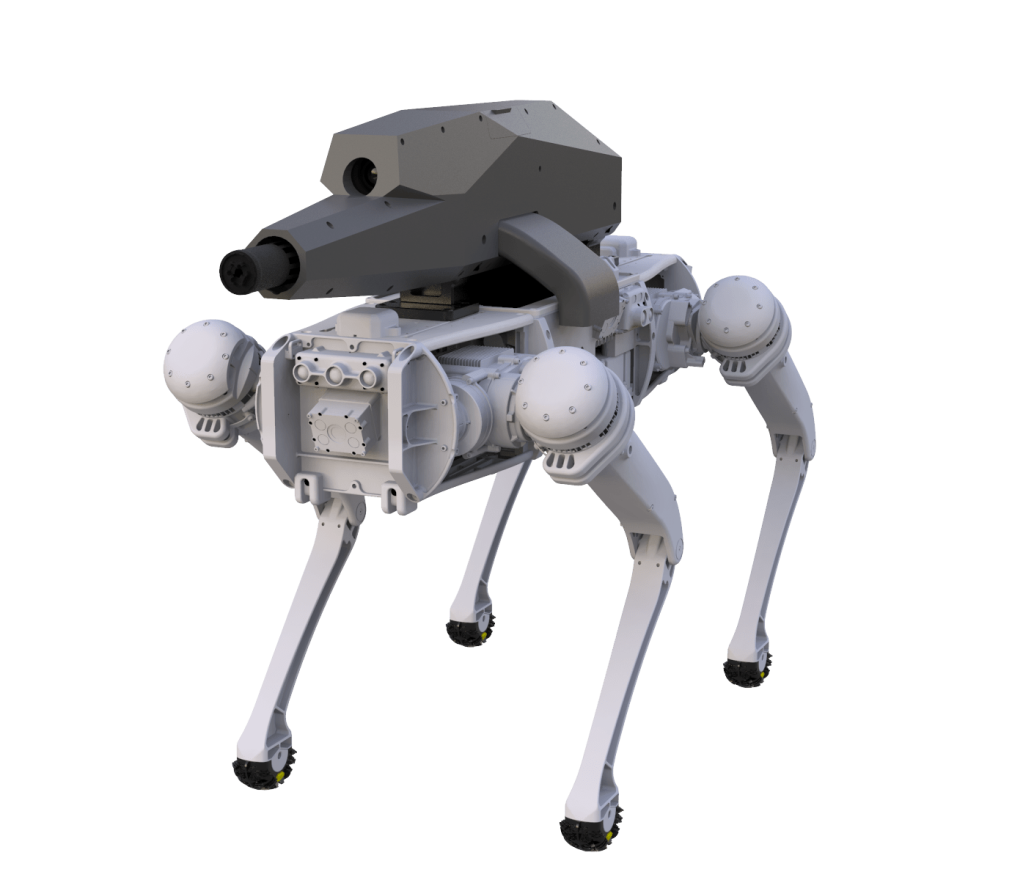Stand aside dogs,
War crimes are a man’s best friend!

https://sworddefense.com/spur/
Where most military contractors develop drone technology to improve their capabilities and can travel higher, further, faster; with even greater precision and data collection capabilities, some companies believe the future of drone technologies lie in the ‘boots on the ground’ mentality. Automated quadrupedal machines will seek to assist or even replace soldiers in the most dangerous environments and scenarios. The Special Purpose Unmanned Rifle, or SPUR for short, appears to attempt exactly that. A four-legged, dog-like machine with a precision rifle strapped to its back.
At the annual meeting of the Association of the United States Army Trade Show & Exhibition, in Washington, D.C. SPUR was unveiled as a series of “versatile, multi-calibre, remote-operated systems designed to be affixed to a variety of air, ground, maritime and static platforms used by the armed forces.” to a mixed result of public opinion. Televised reports and social media were quick to share and publicise the platform, with nervous recognition over debates of autonomy and artificial intelligence.
“versatile, multi-calibre, remote-operated system”
https://sworddefense.com/wp-content/uploads/2021/10/SWORD-SPUR-Press-Release.pdf
In a press release on October 19th, 2021, the creators of SPUD, S.W.O.R.D Defence Systems, reported that they are “considerate of a myriad of debates what arise from the buzzwords” and reiterate the importance that the SPUR platform “is required to be operated by a trained service member” answering some of the more popular discussions that were sparked once a post featuring the image of the robot went viral on social media. A significant aspect that helped virality the post was the significant likeness this holds compared to Boston Dynamic’s SPOT, their own quadrupedal robot ‘dog’ which is now available to the public in professional settings, along with its specialised software.
Both SPOT and SPUR offer impressive mobility and terrain navigation which specialised the platform for numerous tasks, such as an example for a professional utilisation of SPOT is in mapping areas affected by natural disasters such as major earthquakes in which significant damage to built-up areas has been sustained and the traversal of the wreckage may be too dangerous for large groups of rescue services. Utilising their additional LIDAR extensions, they are theoretically able to create accurate maps of the rubble and determine which areas may be safer to begin clearing than others. A further use for SPOT in which operations have already begun is SPOT is used to automate safety inspections in a hydroelectric plant. Where a human being would typically have to manually assess the plant regularly. However, if the journey from the control centre can be cut completely, and the footage or photographs gathered from SPOT can be used to accurately assess whether specific aspects of the turbines are running efficiently, the purpose of a human made journey is cut out and the job made safer and easier. A logical extension of this can be utilised by S.W.O.R.D.S SPUR in which rather than a hydroelectric plant, the platform can be established in a conflict zone. The robot can have its path and movements mapped and repeated to perfection so long as it functions properly, and as such can be a highly reliable and valuable asset in assisting manned patrols.
The mobile robotics platform which SPUR is utilising off of is developed by Ghost Robots and their Q-UGV (Quadrupedal Unmanned Ground Vehicle) robot has already seen effective utilisation and testing in both the US Armed forces and the Australian Armed Forces. In particular, the Australian Armed Forces gave some details in March 2020 of their use of the Ghost Robotics Q-UGV platform and are looking to expand into their newly established Robotic and Autonomous Systems Implementation Office (RICO) which presents the “Army’s interests in Robotic and Autonomous Systems (RAS) / Artificial Intelligence (AI)” An audience for such platforms is seemingly eager and as such the technology will continue to be developed for the foreseeable future.
Whilst the most similarities between SPUR and SPOT lie in their shape and small form factor, this is not Boston Dynamic’s first soirée into the four-legged robot design; their previously developed and recently cancelled ‘Big-Dog’ robot was commissioned by the US Army and DARPA as a pack-mule type robot, capable of securely carrying up to 150 pounds of equipment whilst reliably traversing rough terrain. Whilst the development and results were successful, the project was ultimately canned in 2015 due to poor mechanical-reliability and its gas-powered engine being too loud to take on patrols. However, the technology was repurposed into its smaller cousin SPOT.
So what does SPUR mean for the future of drone warfare?
Whilst the product is very much in the developmental phase, what statistics and details they have shared appear somewhat promising: An effective range of 1200 meters suggests that the platform, as with numerous other precision weaponry that utilises computer targeting systems, are extraordinarily accurate almost one hundred percent of the time. Such a detail provides an observer with the speculative confidence that the platform, when utilised effectively, will be a game changer in boots on the ground operations for both sparing costly human involvement and in the confidence that the platform will operate accordingly. The discussion of human operation via a wireless controller with a live feed shown upon a screen along with the confirmation that the robot will require a human touch in order to pull any trigger, for now, dispels some cautious critics of their morality arguments. However, it may still be awhile, despite promising uses of in-operation studies currently ongoing, it remains likely that it will be a few years away from active independent deployment in a genuine combat scenario.
At least, for now, S.W.O.R.D appears confident in their designs and state that “SPUR is the future of unmanned weapon systems, and that future is now.” So, so long as an economic beneficiary makes itself known, the Q-UGV may be closer to active service than believed.